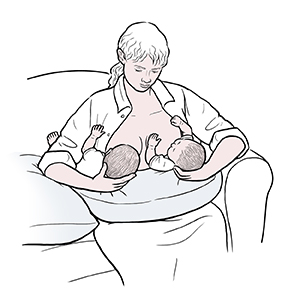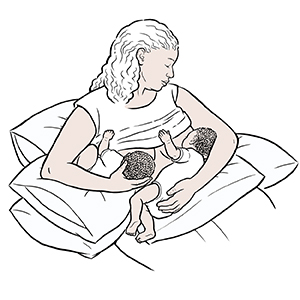Breastfeeding two babies may seem very challenging. But it's possible to do, and rewarding for you and your babies. The more you nurse, the more milk your body makes. And any amount of breastmilk that you can give your babies is important. This sheet will give you tips for nursing your twins.
Getting started…and on a schedule
In the beginning, your babies will need to eat about every 2 to 3 hours around the clock. Each session should last about 20 to 30 minutes. Breastfed babies may at times need to eat every 1 to 2 hours in cluster feedings. It’s helpful to try to get both babies on the same feeding schedule as soon as you can. Otherwise, you’ll find that just as you are putting one baby back to sleep after a feeding, your other baby is waking up and ready to eat.
To help get your babies on the same feeding schedule, follow this rule—When one baby wakes up to eat, wake up the other one. It’s OK to do this. You are not harming your baby by waking them. Over time, your babies will start to move closer to the same schedule on their own.
If your babies were in the neonatal intensive care unit (NICU), they were likely already on a 3-hour schedule. Stick to that same schedule at home.
Some moms choose to nurse their twins one at a time. Or they may start out doing that until they and their babies have had some practice. This can give you special one-on-one time with each baby—something that doesn’t always happen with twins. But it will also take you much longer, and you are less likely to get some rest.
Breastfeeding your twins together
Here are some tips for feeding your twins together:
-
Find a comfy spot. A bed, couch, or a big comfy chair are all good places to breastfeed. Find a place that has room for all of you to be comfortable. Keep handy supplies in reach, such as water and burp cloths.
-
Use a twin nursing pillow. This is a larger pillow made for two babies. It can also be used by your partner, or another caregiver, to bottle-feed breastmilk to the twins using a double football hold.
-
Get help setting up. At first, you’ll need someone to help you. Place the pillow around you. Then have someone give you each baby. Have them latch on one at a time.
-
Get into position. Try different twin nursing positions (see below). Find one that works for you and your babies.
Also be sure to:
-
Bring the babies to your breasts. Make sure your babies come to your breasts, instead of leaning over and bringing your breasts to them. You don’t want to hunch over in an uncomfortable way when you are nursing 8 to 12 times a day.
-
Switch sides when you nurse. Your babies may have different feeding styles. One may nurse more quickly or aggressively than the other. Or one of your breasts may make more milk, or have a stronger let down. Switching sides can keep your breasts from getting lopsided. It can also help your babies develop their eye muscles and coordination at the same time.
-
Pump and store some breastmilk. It can be helpful to do this even though you are breastfeeding. That way, your partner or other caregivers can help out with feedings.
Twin breastfeeding positions
Here are some ways to breastfeed your twins together:
 |
| Double football hold |
 |
| Combined cradle hold and football hold |
 |
| Double-cradle or crisscross hold |
Keep a chart
In those first hectic few weeks at home, it’s helpful to keep track of how much each baby is feeding and on which side. Use a chart or an app to track how much time each baby spends for each feeding. Also track how many wet and dirty diapers each baby has over 24 hours. This will help you easily spot any problems. Bring this chart with you to your babies’ healthcare provider visits.
Taking care of mom
-
Make sure you’re eating and drinking enough. When you’re breastfeeding twins, you need to have about 400 to 500 extra calories for each baby, each day. Try eating foods more often throughout the day, and having healthy snacks. Drinking lots of water is also key.
-
Accept all offers of help from family and friends.
-
Take turns with nighttime feedings. Once your milk supply is well established and the twins have learned to breastfeed, it can be helpful if you and your partner can each handle one overnight feeding. That way, you’ll both get a longer stretch of sleep. For example, you can do the midnight feeding alone. Then your partner can get the 3 a.m. feeding, using pumped breastmilk. But keep in mind that with this approach you may need to wake up to drain your breasts to prevent engorgement.If you have a borderline or low milk supply, you may need to keep draining your breasts regularly. This is to protect your supply from dropping further.
-
Rest when your babies sleep. Resist the urge to clean up or do laundry. Just rest.
Special concerns for twins
Every set of twins is different. Here are some common challenges.
Preemies
Twins are more likely to be born early (premature). One or both babies often need to stay in the NICU. If this is the case, start pumping with a hospital-grade double breast pump as soon as you can after delivery. This will help keep up your milk supply.
Premature babies may not have a fully developed suck-swallow reflex yet. Without this, a baby will have trouble latching on correctly. Some preemies learn to breastfeed in a few weeks. Others may take a few months. While they are learning to nurse, the babies can be fed your breastmilk from a bottle. Or they may be fed breastmilk through a tube.
Different abilities
Your babies may have very different feeding styles or sucking abilities. One may be breastfeeding well and emptying your breast while the other isn’t. When the baby who is not nursing well stops feeding, pump that breast. Your partner or another caregiver can bottle-feed breastmilk so that baby gets a little more.
Getting help
Breastfeeding may be natural. But that doesn’t mean it’s easy to do. And nursing two babies is even more of a challenge. Your babies’ healthcare provider can answer any questions. But it’s also a good idea to find a lactation consultant or a doula who has experience with multiples. They can help you with any issues that come up.
When to call the healthcare provider
Call your twins’ healthcare provider if either baby:
-
Is feeding less often or drinking less at feedings
-
Feeds for less than 10 minutes or more than 40 minutes
-
Is more than 5 days old and doesn’t have at least 5 wet diapers in 24 hours
-
Is having trouble passing poop or has hard poop
-
Has yellow skin
Call your healthcare provider if you:
-
Have cracked, sore, or painful nipples
-
Have a hard, swollen, red, or sore breast
-
Are worried that you’re not making enough milk